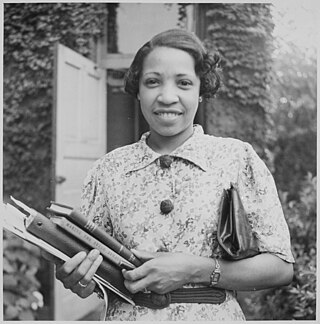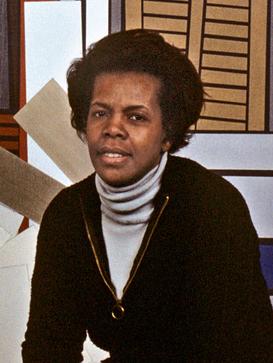Work
- African Fable
- Cattle People
- Death in the Forest
Betty Manyolo illustrated the book Awo olwatuuka. [1]
Betty Manyolo | |
|---|---|
| Born | 1938 |
| Nationality | Uganda |
| Occupation(s) | Painter and Printmaker |
Estelle Betty Manyolo (born 1938) is a Ugandan art painter and printmaker.
Betty Manyolo is a Muganda, and one of ten children. She studied art at the School of Fine Art at Makerere College. Later in her career, she worked as an artist for Uganda's Department of Health.[ citation needed ]
Betty Manyolo illustrated the book Awo olwatuuka. [1]
Several of her linocut prints, along with an oil painting, were exhibited through the Harmon Foundation beginning in 1961; her work was also included in the Smithsonian Institution Traveling Exhibit of Contemporary African Printmakers from 1966 to 1968. [2]

Lois Mailou Jones (1905–1998) was an artist and educator. Her work can be found in the collections of the Smithsonian American Art Museum, The Metropolitan Museum of Art, the National Museum of Women in the Arts, the Brooklyn Museum, the Museum of Fine Arts, Boston, Muscarelle Museum of Art, and The Phillips Collection. She is often associated with the Harlem Renaissance.

Laura Wheeler Waring was an American artist and educator, most renowned for her realistic portraits, landscapes, still-life, and well-known African American portraitures she made during the Harlem Renaissance. She was one of the few African American artists in France, a turning point of her career and profession where she attained widespread attention, exhibited in Paris, won awards, and spent the next 30 years teaching art at Cheyney University in Pennsylvania.
The Louis Comfort Tiffany Foundation was founded in 1918 by Louis Comfort Tiffany to operate his estate, Laurelton Hall, in Cold Spring Harbor, Long Island. It was designed to be a summer retreat for artists and craftspeople. In 1946 the estate closed and the foundation changed its purpose from a retreat to the bestowing of grants to artists.

June Claire Wayne was an American painter, printmaker, tapestry innovator, educator, and activist. She founded Tamarind Lithography Workshop (1960–1970), a then California-based nonprofit print shop dedicated to lithography.
Renée Stout is an American sculptor and contemporary artist known for assemblage artworks dealing with her personal history and African-American heritage. Born in Kansas, raised in Pittsburgh, living in Washington, D.C., and connected through her art to New Orleans, her art reflects this interest in African diasporic culture throughout the United States. Stout was the first American artist to exhibit in the Smithsonian's National Museum of African Art.

Pat Steir is an American painter and printmaker. Her early work was loosely associated with conceptual art and minimalism, however, she is best known for her abstract dripped, splashed and poured "Waterfall" paintings, which she started in the 1980s, and for her later site-specific wall drawings.

Thelma Beatrice Johnson Streat (1912–1959) was an African-American artist, dancer, and educator. She gained prominence in the 1940s for her art, performance and work to foster intercultural understanding and appreciation.
Betty Blayton was an American activist, advocate, artist, arts administrator and educator, and lecturer. As an artist, Blayton was an illustrator, painter, printmaker, and sculptor. She is best known for her works often described as "spiritual abstractions". Blayton was a founding member of the Studio Museum in Harlem and board secretary, co-founder and executive director of Harlem Children's Art Carnival (CAC), and a co-founder of Harlem Textile Works. She was also an advisor, consultant and board member to a variety of other arts and community-based service organizations and programs. Her abstract methods created a space for the viewer to insert themselves into the piece, allowing for self reflection, a central aspect of Blayton's work.

Betsy Graves Reyneau (1888–1964) was an American painter, best known for a series of paintings of prominent African Americans for the exhibition “Portraits of Outstanding Americans of Negro Origin” that, with those by Laura Wheeler Waring and under the Harmon Foundation, toured the United States from 1944 to 1954. A granddaughter of Michigan Supreme Court Justice Benjamin F. Graves, Reyneau's sitters included Mary McLeod Bethune, George Washington Carver, Joe Louis, and Thurgood Marshall. Reyneau's portrait of Carver, the most famous, was the first of an African American to enter a national American collection.
Margo Humphrey is an American printmaker, illustrator and art teacher. She earned a Master of Fine Arts degree from Stanford after earning a Bachelor of Fine Arts degree at the California College of Arts and Crafts in printmaking. She has traveled in Africa, Brazil, the Caribbean, and Europe and has taught in Fiji, Nigeria, Uganda, and the University of Maryland. As a printmaker, she is known for her "bold, expressive use of color and freedom of form", creating works that are "engaging, exuberant and alive." Her work is considered to be "in the forefront of contemporary printmaking."
Betty Nobue Kano is a Japanese painter, curator and lecturer at San Francisco State University and New College of California, teaching the 332 Japanese American Art and Literature class. She is notable for exhibiting her work in nearly 200 regional, national and international galleries and museums, including the Museum of Modern Art in San Francisco.

Katrina Andry is an American visual artist and printmaker. She is based in New Orleans, Louisiana.
Elizabeth Jamaux CurnownéeLe Cren, commonly known as Betty Curnow, was a New Zealand artist and the subject of the iconic Portrait of Betty Curnow by Rita Angus.

Mavis Iona Pusey was a Jamaican-born American abstract artist. She was a printmaker and painter who was well known for her hard-edge, nonrepresentational images. Pusey drew inspirations from urban construction. She was a leading abstractionist and made works inspired by the constantly changing landscape.
Theresa Musoke is a Ugandan-Kenyan painter and visual artist most well known for her experimentational and expressive depictions of Kenyan wildlife and women's experiences in African. She is most widely known for her work in painting and printmaking, but also uses batik, barkcloth, acrylic, and dye, among other materials in her works, even venturing to sculpture on occasion. Musoke describes her works as "semi-abstract" and incorporates themes such as her multinational heritage, African identity as a whole, and feminist themes including domestic roles, motherhood and family planning into her pieces. Musoke's art reflects the turbulent political crisis in which she grew up, representing a diverse mix of systems, media, and styles, both traditional and contemporary, in addition to "decades of change from self-taught traditions to Western art school training, emerging as an art form that celebrates a rich historical and cultural heritage that cannot be understood solely in terms of elements and principles of art and design".
Suzanna Ogunjami was a visual artist of Igbo (Nigerian) ancestry. She emigrated from West Africa to Jamaica and again to New York City, where she was active from 1928–1934 and became the first African woman to have a solo exhibit in a commercial gallery in the United States. She also used the name Suzanne Ogunjami Wilson.
Radia Bent Lhoucine (1912–1994) was a self-taught Moroccan artist who began painting in her later years, and whose work has been exhibited and sold at galleries in Africa and Europe.

Samuel Joseph Brown Jr. (1907–1994) was a watercolorist, printmaker, and educator. He was the first African American artist hired to produce work for the Public Works of Art Project, a precursor to the Work Progress Administration's Federal Art Project. Brown often depicted the lives of African Americans in his paintings. He worked primarily in watercolor and oils, and he produced portraits, landscapes and prints.

Jessie Housley Holliman was an African-American educator, muralist, printmaker, and commercial artist active in St. Louis, Missouri from 1929 until 1949.